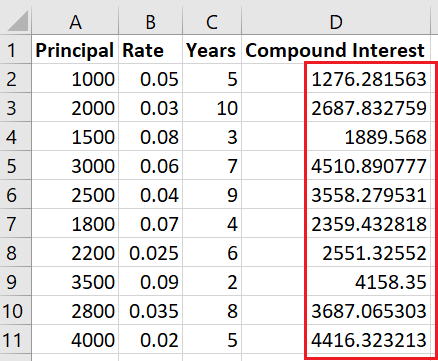Track
Exponentiation is fundamental in various programming areas, from data analysis to algorithm design. Its applications include analyzing exponential patterns in large datasets like social media trends and performing mathematical calculations like compound growth or interest rates.
Furthermore, exponentiation plays a crucial role in Machine Learning (ML) and Artificial Intelligence (AI), especially in neural networks and image recognition. Therefore, understanding how to perform calculations with exponents effectively in Python is essential.
In this guide, we’ll explore various methods for performing exponentiation in Python. We'll examine built-in functions, functions from the math module, and those from the Numpy library. Each method has its advantages. To get a leg up, solidify your understanding, and become an expert, enroll in our Python Programming Fundamentals skill track.
Exponents in Python
Python offers multiple ways to calculate exponents:
-
**: The double asterisk operator (**) is the simplest and basic option for exponentiation. For example,
x ** ycomputesxraised to the power ofy. -
pow(): This built-in function takes two arguments: the base and the exponent. It returns the result of raising the base to the exponent. It also allows an optional third argument for modular exponentiation. Example:
pow(x, y). -
math.pow(): This function from the
mathmodule is similar topow(), but it always returns a floating-point result. It takes two arguments, both of which can be floats or integers. Example:math.pow(x, y). -
math.exp(): Another function from the
mathmodule, it returns the natural exponential of a number, meaningeraised to the power of the argument. Example:math.exp(argument). -
np.power(): This function from the NumPy library is designed for working with arrays or matrices. It performs element-wise exponentiation. Example:
np.power(array, exponent).
Python Exponent Basics
The double asterisk operator (**) is Python's most straightforward way to calculate exponentiation. This operator raises the left operand (base) to the power of the right operand (exponent). It is also called the power operator or exponent operator.
If you want to improve your Python programming skills and learn how to code like a real programmer, check out the course Python Programming.
Positive exponent
In this code snippet, we show how to calculate exponentiation using positive exponents. For example, 2 raised to the power of 3 is calculated as 2 × 2 × 2, resulting in 8. Similarly, -10 raised to the power of 4 is calculated as -10 × -10 × -10 × -10, resulting in 10000.
base = 2
exponent = 3
print(base**exponent) # Output: 8
base = -10
exponent = 4
print(base**exponent) # Output: 10000Negative exponent
This code computes the result of raising a base to a negative exponent. For example, 5 raised to the power of -2 equals 0.04. Similarly, 25 raised to the power of -5 results in a very small value represented in scientific notation (1.024e-07).
base = 5
exponent = -2
print(base**exponent) # 0.04
base = 25
exponent = -5
print(base**exponent) # 1.024e-07Raising a number to a negative exponent is equivalent to taking the reciprocal of the number raised to the positive exponent.

In Python, the ** operator returns a ZeroDivisionError if you raise 0.0 to a negative power because any number divided by zero is undefined.
base = 0
exponent = -5
print(base**exponent)The output is:

Floating point exponent
The code examples show that Python correctly calculates the result of raising a positive base like 2 to a fractional exponent like 1.5. However, using a negative base with a fractional exponent results in a complex number.
base = 2
exponent = 1.5
print(base**exponent) # 2.8284271247461903
base = -0.25
exponent = 1.25
print(base**exponent) # (-0.12500000000000003-0.125j)Diving Deeper: Built-in Functions
Python provides various built-in functions for calculating exponents, but we will focus on two: pow() and math.pow(). At first glance, these functions may appear similar, but they have some significant differences.
pow()
The pow() function takes two mandatory arguments: base and exponent. Optionally, pow() accepts an optional third argument to calculate the modulus of the exponential value. The syntax is as follows: pow(base, exp, mod), where 'mod' represents the modulus. This function returns the remainder of the exponentiation.
Basic exponentiation
For basic calculations, simply provide the base and exponent to the function, which works similarly to the ** operator.
r = pow(2, 3)
print(r) # 8
r = pow(4, -10)
print(r) # 2.56e-06Floating-point exponentiation
In the code below, we're using floating-point numbers for both bases and exponents, some of which are negative. This approach works similarly to the ** operator.
r = pow(3.5, 2)
print(r) # 12.25
r = pow(3.5, -2)
print(r) # 0.08163265306122448
r = pow(3.5, 3.2)
print(r) # 55.08301986166747
r = pow(-3.5, -3.3)
print(r) # (-0.009414432347757688+0.012957854474952653j)
r = pow(-3.5, 3.3)
print(r) # (-36.698070584660925-50.510560868902246j)Note: If you're dealing with basic exponentiation without needing modular calculations, the ** operator is a more concise and readable solution compared to the pow() function.
Modular exponentiation
The optional modulus parameter of the pow() function is highly valuable when working with modular exponentiation. This is particularly useful in cryptography or dealing with large numbers, as modular exponentiation offers improved efficiency. For example, when calculating 3 raised to the power of 4 modulo 5, the result is 1, since 81 modulo 5 equals 1.
r = pow(3, 4, 5)
print(r) # 1
r = pow(123, 456, 789)
print(r) # 699
r = pow(2, -3, 7)
print(r) # 1
r = pow(-13, 8, 62)
print(r) # 7You might wonder why using pow() directly for modular exponentiation is more efficient than pow(base, exp) % mod or (base**exp) % mod. The built-in pow() function is specifically designed for this operation, whereas the other methods perform unnecessary intermediate calculations. This can make a significant difference in performance, especially with large values.
import timeit
start_pow_mod = timeit.default_timer()
pow(500000000, 3000, 4000)
stop_pow_mod = timeit.default_timer()
pow_mod_time = stop_pow_mod - start_pow_mod
print("Time using pow(base, exp, mod): ", pow_mod_time)
start_pow_other = timeit.default_timer()
pow(500000000, 3000) % 4000
stop_pow_other = timeit.default_timer()
pow_other_time = stop_pow_other - start_pow_other
print("Time using pow(base, exp) % mod:", pow_other_time)
start_aestrisk = timeit.default_timer()
(500000000**3000) % 4000
stop_aestrisk = timeit.default_timer()
aestrisk_time = stop_aestrisk - start_aestrisk
print("Time using (base ** exp) % mod: ", aestrisk_time)
print(
f"Speed comparison: pow(base, exp, mod) was {pow_other_time / pow_mod_time} times faster than pow(base, exp) % mod and {aestrisk_time/pow_mod_time} times faster than (base ** exp) % mod"
)The output is:

The pow() function can throw different errors depending on the situation.
# Trying to take the modulo of complex numbers raises a ValueError.
print(pow(2 + 3j, 4, 5)) # ValueError: complex modulo
# Taking the third argument is not allowed if the second argument is negative.
print(pow(10, -11, 4)) # ValueError: base is not invertible for the given modulus
# If the first or second argument is a float, the third argument is not allowed.
print(pow(2.4, 3, 4)) # TypeError: pow() 3rd argument not allowed unless all arguments are integers
# Passing any argument as a string results in a TypeError.
print(pow(2, 4, '3')) # TypeError: unsupported operand type(s) for pow(): 'int', 'int', 'str'math.pow()
The math.pow(x, n) function raises x to the power of n. The math.pow() converts the arguments to floats and returns the result as precise floating-point exponentiation. This precision becomes crucial in fields like data analysis and scientific computing, where accuracy is paramount.
Here’s the simple code. The math.pow() function returns a floating-point value, whereas the pow() function returns an integer value.
import math
print(math.pow(6, 3)) # 216.0
print(pow(6, 3)) # 216The math.pow() function does not accept imaginary numbers.

The math.pow() does not accept negative bases with fractional exponents as it will raise a ValueError.

Leveraging Libraries for Advanced Exponentiation
To handle advanced exponentiation tasks, such as finding the exponential value of a number or calculating element-wise exponentiation in arrays or matrices, you can leverage two functions: np.power() and math.exp() .
np.power()
In Python, exponentiation is not limited to built-in functions. Python has a powerful library called NumPy, which enables a wide variety of mathematical operations on arrays. Sometimes, you need to handle exponentiation across entire arrays, and this is where np.power() comes in. It is designed for element-wise exponentiation of arrays.
import numpy as np
r = np.power([2, 4, 8], 2)
print(r) # [4, 16, 64]
r = np.power([2, 4, 8], [1, 2, 3])
print(r) # [4 64 4096]
r = np.power([[2, 3, 4], [5, 6, 7]], [1, 2, 3])
print(r) # [[2 9 64] [5 36 343]]The np.power() function does not accept a negative exponent.
import numpy as np
r = np.power([2, 4, 8], -2)
print(r)The output is:

If you attempt to raise a negative number to a non-integer power, NumPy will return a NaN (Not a Number) value.

math.exp()
The math.exp(x) function computes the exponential value of x, which is equivalent to raising Euler's number e to the power of x. Euler's number is approximately equal to 2.71828, and in mathematical notation, this operation is represented as e^x.
import math
x = 2
r = math.exp(x)
print("Exponential of", x, ":", r) # 7.38905609893065A significant feature of math.exp(x) is its adaptability. It can handle positive numbers, negative numbers, and even floating-point numbers.
import math
print(math.exp(-2)) # 0.1353352832366127
print(math.exp(-2.5)) # 0.0820849986238988
print(math.exp(2.5)) # 12.182493960703473Practical Applications and Examples
Exponentiation is a fundamental operation in mathematics with numerous applications in data analysis and scientific computing.
If you want to master the basics of data analysis with Python, check out the course Introduction to Python for Data Science.
Let's say you have a CSV file containing data on principal amount, interest rate, and investment period for multiple rows. You can calculate the compound interest for each row using any of the methods discussed above.
Principal,Rate,Years
1000,0.05,5
2000,0.03,10
1500,0.08,3
3000,0.06,7
2500,0.04,9
1800,0.07,4
2200,0.025,6
3500,0.09,2
2800,0.035,8
4000,0.02,5Here’s the code:
import csv
def compound_interest(principal, rate, years):
return principal * (1 + rate) ** years
# Read data from CSV file
data = []
with open("data.csv", newline="") as csvfile:
reader = csv.DictReader(csvfile)
for row in reader:
row["Compound Interest"] = compound_interest(
float(row["Principal"]), float(row["Rate"]), int(row["Years"])
)
data.append(row)
# Write data to a new CSV file with compound interest column
output_file = "data.csv"
fieldnames = ["Principal", "Rate", "Years", "Compound Interest"]
with open(output_file, mode="w", newline="") as csvfile:
writer = csv.DictWriter(csvfile, fieldnames=fieldnames)
writer.writeheader()
for row in data:
writer.writerow(row)
print("Compound interest calculations saved to", output_file)The result is:

Great! You've calculated compound interest for all rows and stored it in a separate column. You can use this data for further analysis. Similarly, there are hundreds of other use cases where exponentiation is used extensively, such as modeling population growth over time.
Conclusion
In this guide, we explored five different methods for calculating exponents in Python, each offering unique advantages. You can use them for many practical scenarios, such as finding compound interest, modeling population growth, and more.
- Double-asterisk operator (**): Simple and direct for everyday use.
- pow(): Versatile with an optional "modulus" trick.
- math.pow(): Precise results as floating-point numbers.
- np.power(): Powerful for handling arrays with error checking.
- math.exp(): Dedicated tool for calculating the exponential value.
If you want to grow your statistical skills and learn how to collect, analyze, and draw accurate conclusions from data using Python, check out the course Introduction to Statistics in Python.
Learn Python From Scratch
Python Exponent FAQs
When should I use math.pow() instead of the ** operator in Python?
Use math.pow() when you need precise floating-point results for scientific or data analysis purposes. If simplicity is your goal and the calculation doesn’t involve floating-point precision, the ** operator is sufficient.
Can Python handle negative exponents or fractional exponents?
Yes, Python supports negative and fractional exponents:
- Negative exponents: Use the
**operator orpow()to calculate the reciprocal of a number raised to a positive power. - Fractional exponents: Use the
**operator ormath.pow(). Note that a negative base with a fractional exponent results in a complex number.
How is modular exponentiation implemented in Python, and why is it efficient?
Modular exponentiation can be performed using the pow() function with three arguments: pow(base, exp, mod). It’s more efficient than computing (base**exp) % mod because pow() is optimized for large numbers, reducing intermediate calculations.
Why does NumPy’s np.power() return an error for negative exponents?
np.power() is designed for array computations and does not support negative exponents because they imply division, which is not compatible with all array types. Use alternative methods like ** or pow() for such calculations.


